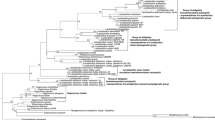Abstract
PCR methods have been shown to be biased by several factors. In the present study, we have developed a theoretic and practical approximation to elucidate how the presence of mismatches at the primers annealing regions and the different number of rDNA operons per cell can influence PCR and subsequent restriction fragment length polymorphism (RFLP) analyses from bacterial populations. We have performed RFLP analyses of 16S rRNA genes amplified by PCR from mixed bacterial cultures showing different primer identities and number of rDNA operons. Our results clearly corroborate that both factors, number of rDNA operons and primers identity, clearly influence the 16S rDNA-RFLP estimations. It has been demonstrated that a higher number of operons leads to a higher efficiency of detection, but a lower degree of primer complementarity implies a decrease in such efficiency.
Similar content being viewed by others
Author information
Authors and Affiliations
Rights and permissions
About this article
Cite this article
Ramírez-Moreno, ., Méndez-Álvarez, ., Martínez-Alonso, . et al. Factors Affecting Interpretation of Restriction Fragment Length Polymorphism (RFLP) Patterns from PCR-Amplified Bacterial 16S rRNA Genes: Operon Number and Primer Mismatching. Curr Microbiol 48, 285–290 (2004). https://doi.org/10.1007/s00284-003-4160-z
Issue Date:
DOI: https://doi.org/10.1007/s00284-003-4160-z




